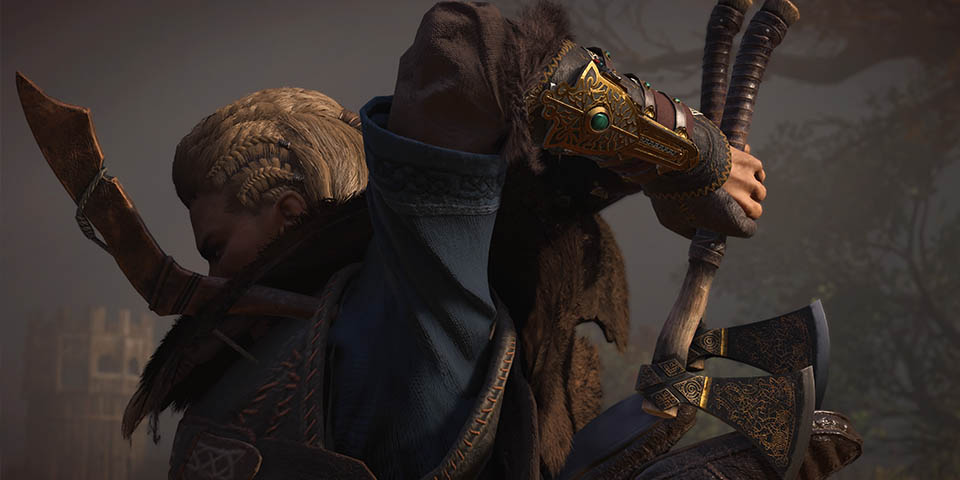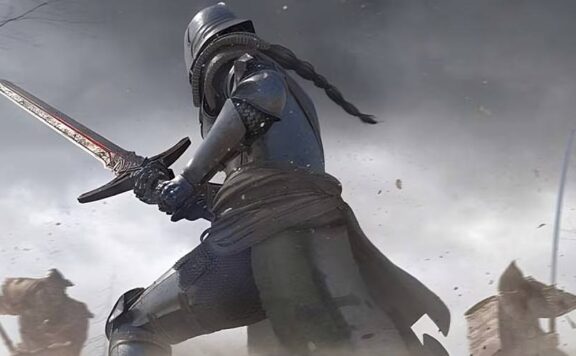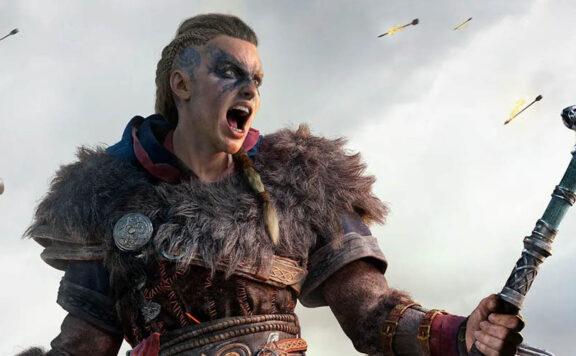The Vikings get a rough time of it in our modern collective consciousness: barbaric, violent, hairy, smelly, frothy mouthed, and partial to a spot of pillaging. Or at least, that’s what I learned in primary school. But is this interpretation fair? It’s certainly one that Ubisoft are seeking to rebuff with Assassin’s Creed: Valhalla which, as well as being the latest exciting instalment in the long running series, also appears to offer a much more nuanced view of Viking life in the 9th Century. Vikings are depicted as farmers, as friends, as traders and explorers, not just as warriors.
But, let’s face it, with this being an action video game, it’s the interactive violence that we are drawn to. As I watched the gameplay previews, walkthroughs and trailers, my eye was taken by the combat style demonstrated by Eivor, the game’s lead protagonist. Is this really how a Viking would fight? Did Vikings use a bow and arrow? I thought they were all about the axes? Would a throwing axe really hit anything? Or would it just embarrassingly and painfully imbed itself in the would-be thrower’s foot? These are all questions we need answering.
So who better to ask than Viking experts in the forms of William R. Short, the manager of Hurstwic LLC, and Hurstwic’s representative in Iceland, Reynir Alfreð Óskarson. If anyone could answer my questions, it would be William and Reynir, after all, they and their colleagues at Hurstwic have been “using the scientific method to reverse engineer how Vikings fought” for the last twenty years.
Call in the experts!
I asked for more information on how this reverse engineering takes place, mostly just so I looked a bit clever. William obliged: “We consider all the available sources and clues, and layer them on top of one another to see if they break or if they hold. We seek to find the common thread that ties the available information together and leads us towards a (somewhat) clear picture of how Vikings fought and used their weapons.”
I nodded sagely so it looked like I understood. Even if I didn’t quite comprehend what William was saying, it soon became clear that Hurstwic had an impressive level of success in this endeavour. As William told me:
This research has resulted in some interesting accomplishments recently, work that has received the attention and approval of leading organizations. For example, we have dug deep into the Viking empty-hand combat method called glíma, a word also used to describe the modern wrestling that is Iceland’s national sport.
This work has been acclaimed as ground-breaking by the National Glíma Association of Iceland, along with the current and former chairmen. Additionally, with the cooperation of archaeologists researching Viking-age house sites, we have explored the escape tunnels that were a part of many Viking homes, used in case of attack. We were invited to give a lecture to the Icelandic Archaeological Society on our combat research. Hurstwic successfully led an international research program to uncover the lost secrets of Viking-age iron making in Iceland.
Let’s face it, that’s an impressive resume, but before I could bombard William with Viking related questions, he had an important caveat to state. “The game is clearly intended for entertainment (and not as a history lesson), set in a world where the rules of the real world don’t always apply and can be bent. We appreciate it when entertainment companies make the Vikings their focus and teach some history at the same time. Yet, a pure history lesson will never make for an entertaining game, and a game will never make for a history lesson. There will always be some give and take in trying to balance these two goals.”
Well said. So, are there any definitive sources we can draw upon that demonstrate an authentic Viking fighting style? William’s response was illuminating, “The Vikings didn’t leave us with fully detailed sources on what is the ‘authentic’ way to fight, and it quite possibly differed from one Viking warrior to the next. Based on all this, we think the interpretation of what is ‘authentic’ and what is not must be kept open and flexible.”
That’s the challenge facing a modern historian, that it’s rare to even have the full and entire historical picture.
Viking weapons – myths and truths
First things first then, let’s talk different types of weapons. I’ve always been under the impression that axes were a Viking’s best friend and they wouldn’t bother wielding anything else. Yet Eivor, the protagonist of Assassin’s Creed, is frequently shown utilising a nifty bit of archery to fell distant targets. Is there any historical evidence for Vikings using a bow and arrow in warfare?
“Yes,” William responded. “There are many examples of bows being used, especially in mass battles and in naval battles where a large number of warriors would not be in range to use their conventional weapons. Using a bow against someone in a fortification is mentioned numerous times in the literary sources. In archaeology, we see arrow heads intended to penetrate mail and make the kill despite the opponent’s wearing armour.”
So, bows and arrows, yes, but throwing axes? One of Eivor’s abilities is to throw an axe with lethal accuracy into an unaware Anglo-Saxon’s mush, but is this even remotely possible? William had my query covered: “Every weapon can be effective, and every target can be hit if the universe bends to your rules. Throwing axes are a real thing, but Viking axes were not throwing axes. The physics of the Viking axe makes it less than suitable as a throwing weapon. The physics of the weapon tell us that in the chaos of combat, it is unlikely to hit the target in a way to do lethal damage because of the way it rotates in flight. There are a few examples of axes being thrown in the literary sources, usually as a move of desperation.”
Definitely more of an awesome video game thing than a real-life thing, then. But what about double handed axes? Eivor is shown wanging around a massive war axe without a care in the world, but would this really be a good idea? If it was me in a battle – heaven forbid, as I’d be rubbish – then I’d want to spend all my time hiding behind a big thick shield, having to use both hands hefting a big axe would prevent me from doing that. I’m guessing it’s a strong no to war axes then?
William took down my assumption with relish. “A two-handed axe (which some call a Dane axe, even though that term would have been unknown to the Vikings) is a real and formidable Viking weapon. There are numerous axes of this type found in the archaeological record and seen in pictorial sources.” He continued, “the literary sources often say that an axe blow to the head split the skull down to the shoulders. We tested this move with a sharp replica two-handed axe and an animal carcass, and the result was just as described: the axe split the skull and was stopped when it hit the spinal column. As effectiveness goes, it’s not a tool one would be keen on meeting; it is formidable.”
This is the brilliant thing about experts. They take our assumptions – which are, let’s face it, usually woefully incorrect – and dropkick them into the stratosphere.
Berserker rage
I had a follow up question: Eivor is also seen sans shield and hacking up foes with two axes, was this a real thing? And, if so, does that mean that Vikings were less concerned with self-preservation and just resorted to going wild?
There are many examples of warriors dual wielding, with a weapon in each hand. While the pictorial sources (such as Viking-age picture stones) rarely show actual combat, there are examples of warriors with different weapons in each hand on the stones. We disagree with the statement that Vikings fought wildly and without any sense of self-preservation.
For example, Vikings are well known for using a shield; that in itself tells us that they were concerned in some way with their self-preservation. On the other side of the coin, it is quite clear from the sources that defence and self-preservation were not as crucial to a Viking as was cutting the opponent down. Viking-age people believed the moment of their death was predestined, and nothing they did could change that moment. What was important was how you were remembered after the day of your death. One of the more famous verses in the poem that allegedly came from Óðin himself states that everyone dies: your cattle, your kin, and you yourself, but a good reputation never dies.
Looks that could kill
I guess predestined death and a ticket to Valhalla would certainly be a reassurance when it came to the prospect of facing a painful death. Also, if you’re going to die, you might as well die looking good. That brings me onto our next questions: did real Vikings wear makeup?
“We know of no evidence that suggests that Vikings wore makeup,” William told me, though he did offer a fascinating insight into Viking grooming.
“What we can probably say with some certainty is that Viking-age people were clean and neatly groomed. We see that in pictorial sources, such as a carving of a man’s head with a trimmed beard and neat, long hair sticking out from under his helmet. Combs and grooming aids are common archaeological finds. There are countless examples in literary sources telling of the desire of the Viking people to take regular baths, and there are treaties between Viking people and other lands that require the Vikings be provided with all the hot water they demand for their baths. It also seems likely that men would routinely have beards. There is at least one famous example in the literary sources of a man who could not grow a beard who was mocked, an insult that resulted in multiple deaths.” I think anyone with a regularly mocked patchy beard can relate to the desire to commit murder. I wouldn’t know though, I absolutely don’t have that problem. My moustache definitely joins up with the rest of my beard. Honest.
In summation then, the Viking’s and their fighting style depicted in Assassin’s Creed: Valhalla looks like an informed interpretation of cutting edge historical research. I’ll let William finish the round-up, “there are many good things about the gameplay, as it relates to Viking combat. It captures some of the brutality that we feel was at the core of Viking combat. It avoids the technique-driven approach to combat that we feel was not part of Viking combat. It features women combatants (skjaldmær, the shield maidens discussed in several literary sources and seen in pictorial sources), a fascinating topic that is currently much debated, with conflicting points of view. And it brought in to the world of the game aspects of Viking culture that are well supported: Niflheim, Valhöll, and others.” I, for one, am very excited to check out the combat of Assassin’s Creed Valhalla on release day, armed and well equipped with a little more historical knowledge than I had before.
A massive thank you to William R. Short and Reynir Alfreð Óskarson for lending their time and expertise. Find out more about Hurstwic and their work over on their website. You can also say hello on Facebook or check out their YouTube Channel. Finally, they have created a series of Viking combat training videos, as well as two feature-length edu-tainment documentaries on the Great Battles of the Viking Age which can be found here.
If you’d like to read the original Interview Transcript you can do so here. It’s packed with fascinating historical insights for your eyeballs.
Playing with History is our ongoing series spotlighting video games and the real-world people and events that inspire them. From walking with dinosaurs in Jurassic World Evolution and talking real-life zombies in Days Gone, to learning about the Peaky Blinders, and chatting Ghost of Tsushima with a samurai expert, there’s plenty you may not have known about your favourite video games.










Dominic L
This is brilliant! I will now think about this the whole time I’m playing through ACV!